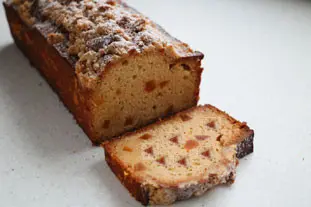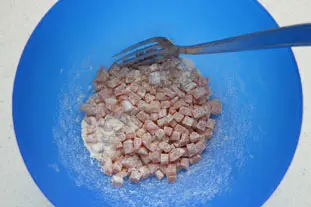This site uses only a few technical cookies necessary for its operation. By continuing to browse, you accept their use.
To find out more...
To find out more...
The cake and the raisins

When you bake a cake, like a cake or pound cake, you may have already encountered this thorny problem: How to make sure that the raisins, or the candied fruits, or any other small filling, do not fall to the bottom of the pan during the baking process?
15 K 4.7/5 (22 reviews)
Keywords for this post:CakeCakePastryRaisinsDoughFillingLast modified on: May 31th 2019
The cake and the raisins
It's not that simple to have this even distribution, basically you want to have this:
Rather than this:
For this, or rather to avoid the second option, bakers all learn in their training the following method (let's say you want to make a cake with diced candied orange):
You put the diced candied oranges (or raisins, etc.) in a bowl, and sprinkle them with a little flour taken from the flour provided for the cake batter. Note that no extra flour is added.
Mix everything carefully, with a fork, to coat all the orange cubes with flour.
This is quite easy with candied fruit because it is sticky, if you use raisins that are a little too dry, to which the flour does not stick, moisten them very slightly (1 tablespoon of water) before pouring in the flour.
Then make your cake batter as normal, add the excess flour from the bowl, and just before putting into the tin, add the floured candied fruit, mix quickly, put into the tin and bake.
Well, I have to be honest with you, it's not a 100% sure method, the great Gaston Lenôtre himself, when he explains this method in his books, adds at the end "in theory...".
So I propose you another method that I like:
To sum up: To prevent the filling of a cake from falling to the bottom of the pan when baking, you have to either coat the filling with a little flour, or incorporate the filling into a very cold dough, or both.

Rather than this:

For this, or rather to avoid the second option, bakers all learn in their training the following method (let's say you want to make a cake with diced candied orange):
You put the diced candied oranges (or raisins, etc.) in a bowl, and sprinkle them with a little flour taken from the flour provided for the cake batter. Note that no extra flour is added.

Mix everything carefully, with a fork, to coat all the orange cubes with flour.
This is quite easy with candied fruit because it is sticky, if you use raisins that are a little too dry, to which the flour does not stick, moisten them very slightly (1 tablespoon of water) before pouring in the flour.
Then make your cake batter as normal, add the excess flour from the bowl, and just before putting into the tin, add the floured candied fruit, mix quickly, put into the tin and bake.
Well, I have to be honest with you, it's not a 100% sure method, the great Gaston Lenôtre himself, when he explains this method in his books, adds at the end "in theory...".
So I propose you another method that I like:
- You make your dough normally, once finished, you do not put it in the mold, but in the refrigerator for at least 1 hour
- At the end of this time, the dough will have firmed up because of the butter it contains => add the raisins or candied fruits at this time, and stir well (be careful, it is much harder than a dough coming out of the mixer)
- Put it in a mould and put it in the oven immediately
To sum up: To prevent the filling of a cake from falling to the bottom of the pan when baking, you have to either coat the filling with a little flour, or incorporate the filling into a very cold dough, or both.
Lasts posts
Butter vs. grease
We often read in a recipe where a pastry is put into a mould that, just before pouring, the mould should be buttered or greased. But what's the difference between these 2 terms?December 1st 20259705
Getting out of the fridge early
Very often when you're cooking, you need to take food or preparations out of the fridge, to use them in the recipe in progress. There's nothing tricky about this: you just take them out of the fridge and use them, usually immediately, in the recipe. But is this really a good method?November 24th 20251,1035
Who's making the croissants?
When you look at a bakery from the outside, you naturally think that in the bakery, the bakers make the bread, and in the laboratory, the pastry chefs make the cakes. It's very often like that, with each of these professions having quite different ways of working, but sometimes there's also one...November 23th 2025998
Oven height
When we put a dish or cake in the oven, we naturally tend to put it on the middle shelf, and that's what we usually do. But in some cases, this position and height can be a little tricky, so let's find out why.October 8th 20252,7205
The importance of sieving
In recipes that use a fine powder (flour, powdered sugar, etc.), you'll often see the advice to sift before using it. To sift is to pass the powder in question through a sieve (a very fine strainer) before incorporating it into your recipe. It's often advice, but is it really useful?September 3rd 20257,5273
Other pages you may also like
The window-pane test in bread-making
The home bread-makers often ask themselves “Have I kneaded my dough long enough?” . A good question, as dough that is insufficiently kneaded will not rise properly or will fall flat when the top is slashed, which is very frustrating. To know when the dough is ready, one can rely on the length...June 16th 202196 K 23.9
A few tips for effective kneading at home
When you have to knead dough for bread or some other recipe, you may well use a food processor or the type of machine known as a stand mixer. The best-known brands are Kenwood and KitchenAid. They are useful tools, but here are a few tips to help you get the best out of them.June 23th 2021284 K 23.8
Egg yolks and caster sugar
We often come across recipes where we need to mix egg yolks with caster sugar. This would appear to be a very ordinary and simple thing to do but, be warned, these two ingredients can behave oddly together.February 15th 201883 K 24.3
85 grams of eggs?
Some time ago, I already spoke to you about the difference between baking and pastry-making, I emphasized, among other things, the precision of pastry-making which requires grams, cm, degrees and minutes. That's why, on the one hand, you have baking and cooking, where a certain tolerance is...November 26th 201856 K4.6
For well opened (puffed) cakes
It's always nice to have a well puffed up cake after baking, not only will it taste good but it looks great too. Let's see how to get this beautiful shape almost every time.January 23th 201935 K4.2
Post a comment or question
Follow this page
If you are interested in this page, you can "follow" it, by entering your email address here. You will then receive a notification immediately each time the page is modified or a new comment is added. Please note that you will need to confirm this following.
Note: We'll never share your e-mail address with anyone else.
Alternatively: you can subscribe to the mailing list of cooling-ez.com , you will receive a e-mail for each new recipe published on the site.









